Assessing Local Power Generation Potentials of Photovoltaics, Engine Cogeneration, and Heat Pumps: The Case of a Major Swiss City
Abstract
:1. Introduction
2. Related Literature
3. The Swiss Energy Sector and Policy
3.1. Status-Quo: Production and Consumption
3.2. Power Generation from the Swiss Technology Mix
3.3. Future Development: Energy Strategy 2050
4. Calculation of the Local Power and Heat Generation Potentials of a City
4.1. Data Used
4.2. Technologies Considered
4.3. Scenarios Considered
5. Analysis and Evaluation
5.1. Method
5.2. Results
5.2.1. Variant 1: Estimated Real Energy Procurement Costs
5.2.2. Variant 2: Increased Electricity Procurement Costs
5.2.3. Variant 3: Increased CO2eq Emissions of Electricity
5.3. Discussion of the Study’s Limitations
6. Conclusions
Author Contributions
Funding
Data Availability Statement
Conflicts of Interest
Abbreviations
| ASUE | Arbeitsgemeinschaft für sparsamen und umweltfreundlichen Energieverbrauch e.V. (German Association for a Rational and Environmentally Benign Energy Consumption) |
| CB | Condensing boiler |
| CHP | Combined heat and power |
| COP | Coefficient of performance |
| CO2eq | Carbon dioxide equivalent |
| DER | Distributed energy resources |
| DG | Distributed generation |
| DGST | Decentralized generation and storage technology |
| ENT | Electricity network |
| ENSI | Swiss Federal Nuclear Safety Inspectorate |
| EPFL | École Polytechnique Fédérale de Lausanne |
| FIT | Feed-in tariff |
| GCB | Gas-fired condensing boiler |
| HP (AWHP, WWHP) | Heat pump (air/water, water/water) |
| LCOE | Levelized costs of electricity |
| NPP | Nuclear power plant |
| PV | Photovoltaics |
| P2G | Power to gas |
| RS | Reference scenario |
| RZVN | Rechenzentrum für Versorgungsnetze Wehr GmbH |
| SFOE | Swiss Federal Office of Energy |
| VBA | Visual Basic for Applications |
| VRES | Variable renewable energy sources |
References
- Ceglia, F.; Esposito, P.; Marrasso, E.; Sasso, M. From smart energy community to smart energy municipalities: Literature review, agendas and pathways. J. Clean. Prod. 2020, 254, 120118. [Google Scholar] [CrossRef]
- Yazdanie, M.; Densing, M.; Wokaun, A. The role of decentralized generation and storage technologies in future energy systems planning for a rural agglomeration in Switzerland. Energy Policy 2016, 96, 432–445. [Google Scholar] [CrossRef]
- Orehounig, K.; Mavromatidis, G.; Evins, R.; Dorer, V.; Carmeliet, J. Towards an energy sustainable community: An energy system analysis for a village in Switzerland. Energy Build. 2014, 84, 277–286. [Google Scholar] [CrossRef]
- Madlener, R.; Vögtli, S. Diffusion of bioenergy in urban areas: A socio-economic analysis of the Swiss wood-fired cogeneration plant in Basel. Biomass Bioenergy 2008, 32, 815–828. [Google Scholar] [CrossRef]
- Bayansalduz, M.; Knoeri, C.; Madlener, R. Technical Potential and Market Diffusion of Smart Energy Hubs: An Agent-Based Modeling Approach, FCN Working Paper No. 24/2019; Institute for Future Energy Consumer Needs and Behavior (FCN), RWTH Aachen University: Aachen, Germany, 2019. [Google Scholar]
- Energieperspektiven 2050. Study on Behalf of the Swiss Federal Office of Energy (SFOE); SFOE: Bern, Switzerland, 2012. [Google Scholar]
- Energieperspektiven 2050+. Study on Behalf of the Swiss Federal Office of Energy (SFOE); SFOE: Bern, Switzerland, 2020. [Google Scholar]
- Technology Collaboration Programme by IEA. TIMES. Available online: https://iea-etsap.org/index.php/etsap-tools/model-generators/times (accessed on 31 March 2021).
- HOMER Energy by, UL. HOMER Pro. Available online: https://www.homerenergy.com/products/pro/index.html (accessed on 31 March 2021).
- Ringkjøb, H.-K.; Haugan, P.M.; Solbrekke, I.M. A review of modelling tools for energy and electricity systems with large shares of variable renewables. Renew. Sustain. Energy Rev. 2018, 96, 440–459. [Google Scholar] [CrossRef]
- Andersson, G.; Boulouchos, K.; Bretschger, L.; Boes, R.; Brütsch, F.; Filippini, M.; Leibundgut, H.; Mazzotti, M.; Noembrini, F.; Ramer, R. Energiezukunft Schweiz; ETH Zurich: Zurich, Switzerland, 2011. [Google Scholar]
- Dyllick-Brenzinger, R.M.; Yoon, D.C.; Püttgen, H.B. Neue Energiestrategie 2050: Das Zusammenspiel von Fotovoltaik und Speichertechnologien. Available online: https://infoscience.epfl.ch/record/182135/usage (accessed on 29 August 2021).
- Prognos AG. Maßnahmen zur Nachhaltigen Integration von Systemen zur gekoppelten Strom-und Wärmebereitstellung in das Neue Energieversorgungssystem. Study on Behalf of BDEW and AGFW; Prognos AG: Berlin, Germany, 2013; Volume 11. [Google Scholar]
- Wagner, U.; Heilek, C.; Held, A. Energiewirtschaftliche Bewertung der Wärmepumpe in der Gebäudeheizung; Technical University of Munich (TUM): Munich, Germany, 2009. [Google Scholar]
- Swiss Federal Office of Energy (SFOE). Schweizerische Gesamtenergiestatistik. 2019. Available online: https://www.bundespublikationen.admin.ch/cshop_mimes_bbl/14/1402EC7524F81EDAB0D4ADA2322CB657.pdf (accessed on 21 February 2021).
- Brunner, F.; Iten, T. Strommix 2019—Umweltbelastung aus der Stromproduktion der vier Größten Schweizer Stromversorger. 2019. Available online: https://energiestiftung.ch/files/energiestiftung/publikationen/pdf/20200717_Kurzstudie_Strommix_2019.pdf (accessed on 22 March 2021).
- Umweltbundesamt. Entwicklung der Spezifischen Kohlendioxid-Emissionen des Deutschen Strommix 1990–2018. Available online: https://www.umweltbundesamt.de/bild/entwicklung-der-spezifischen-kohlendioxid-1 (accessed on 22 March 2021).
- Koordinationskonferenz der Bau- und Liegenschaftsorgane der Öffentlichen Bauherren (KBOB). Ökobilanzdaten im Baubereich. Available online: https://www.kbob.admin.ch/dam/kbob/de/dokumente/Publikationen/Nachhaltiges%20Bauen/Archiv_2005-2009/Empfehlung_Oekobilanzdaten_Baubereich_2009_1_2016.pdf.download.pdf/Empfehlung_Oekobilanzdaten_im_Baubereich_2009_1_2016.pdf (accessed on 28 March 2021).
- Swiss Parliament. Langzeitbetriebskonzepte für die Kernenergie. Available online: https://www.parlament.ch/press-releases/Pages/2014/mm-urek-n-2014-08-26.aspx?lang=1031 (accessed on 21 February 2021).
- Swiss Federal Office of Energy (SFOE). Nuclear Energy. Available online: https://www.bfe.admin.ch/bfe/en/home/supply/nuclear-energy.html (accessed on 21 February 2021).
- Swiss Federal Office of Energy (SFOE). Hydropower. Available online: https://www.bfe.admin.ch/bfe/en/home/supply/renewable-energy/hydropower.html (accessed on 21 February 2021).
- Swiss Federal Office of Energy (SFOE). Wasserkraftpotenzial der Schweiz. Available online: https://www.bfe.admin.ch/bfe/en/home/versorgung/erneuerbare-energien/wasserkraft.exturl.html/aHR0cHM6Ly9wdWJkYi5iZmUuYWRtaW4uY2gvZGUvcHVibGljYX/Rpb24vZG93bmxvYWQvOTgxNQ==.html (accessed on 21 February 2021).
- Kernkraftwerk Gösgen-Däniken AG. Die Schweizer Kernkraftwerke. Available online: https://www.kkg.ch/de/i/die-schweizer-kernkraftwerke-_content---1--1240--239.html (accessed on 21 February 2021).
- Swiss Federal Office of Energy (SFOE). What is the Energy Strategy 2050? Available online: https://www.bfe.admin.ch/bfe/en/home/policy/energy-strategy-2050/what-is-the-energy-strategy-2050.html (accessed on 21 February 2021).
- Swiss Federal Office of Energy (SFOE). Initial Package of Measures. Available online: https://www.bfe.admin.ch/bfe/en/home/policy/energy-strategy-2050/initial-package-of-measures.html (accessed on 21 February 2021).
- Swiss Federal Office of Energy (SFOE). Measures for the Development of Renewable Energies. Available online: https://www.bfe.admin.ch/bfe/en/home/policy/energy-strategy-2050/initial-package-of-measures/measures-for-the-development-of-renewable-energies.html (accessed on 21 February 2021).
- United Nations. Framework Convention on Climate Change (UNFCCC). Adoption of the Paris agreement. In Proceedings of the 21st Conference of the Parties, Paris, France, 30 November–11 December 2015. [Google Scholar]
- Rechenzentrum für Versorgungsnetze Wehr GmbH (RZVN). Unternehmensprofil. Available online: https://www.rzvn.de/unternehmen.html (accessed on 21 February 2021).
- Flayyih, M.; Burmeister, F.; Stinner, S.; Kraft, W. Modelica—Simulation des Systems Nutzer/Gebäude/Anlagentechnik; Study on Behalf of DVGW Deutscher Verein des Gas- und Wasserfaches e. V.: Bonn, Germany, 2013. Available online: https://www.dvgw.de/medien/dvgw/forschung/berichte/g5_05_10.pdf (accessed on 29 August 2021).
- European Commission (EC). Photovoltaic Geographical Information System. Available online: https://re.jrc.ec.europa.eu/pvg_download/map_index.html (accessed on 21 February 2021).
- Wagner, H.-J.; Koch, M.K.; Burkhardt, J.; Bockmann, T.G.; Feck, N.; Kruse, P. Fachthemen-Emissionen—CO2-Emissionen der stromerzeugung—Ein ganzheitlicher vergleich verschiedener techniken. BWK Energ. Fachmag. 2007, 59, 44–52. [Google Scholar]
- Nipkow, F.; Iten, T. Ländervergleich 2019—Solar- und Windenergieproduktion der Schweiz im Europäischen Vergleich. Available online: https://energiestiftung.ch/files/energiestiftung/fliesstextbilder/Studien/Laendervergleich%202020/Kurzstudie_Laendervergleich_2019%20kleine%20datei.pdf (accessed on 21 February 2021).
- Swiss Federal Office of Energy (SFOE). Förderung der Photovoltaik—Faktenblatt. Available online: https://www.bfe.admin.ch/bfe/de/home/foerderung/erneuerbare-energien/einspeiseverguetung.exturl.html/aHR0cHM6Ly9wdWJkYi5iZmUuYWRtaW4uY2gvZGUvcHVibGljYX/Rpb24vZG93bmxvYWQvNzIzOA==.html (accessed on 21 February 2021).
- Verbraucherzentrale, N.R.W. Mittlere Preise für Photovoltaikanlagen Inklusive Montage. 2019. Available online: https://www.verbraucherzentrale.nrw/sites/default/files/2020-06/PV-Preisindex_0.jpg (accessed on 26 March 2021).
- Solaranlagen-Portal. Kosten für Photovoltaik. Available online: https://www.solaranlagen-portal.com/photovoltaik/kosten (accessed on 21 February 2021).
- Arbeitsgemeinschaft für Sparsamen und Umweltfreundlichen Energieverbrauch e.V. (ASUE). BHKW-Fibel. Available online: http://asue.de/blockheizkraftwerke/broschueren/05_03_15_bhkw-fibel_-_2015 (accessed on 21 February 2021).
- Arbeitsgemeinschaft für Sparsamen und Umweltfreundlichen Energieverbrauch e.V. (ASUE). BHKW-Kenndaten 2014/15. Available online: https://asue.de/node/1833 (accessed on 21 February 2021).
- Statista. Inflationsrate in Deutschland von 1992 bis 2020. Available online: https://de.statista.com/statistik/daten/studie/1046/umfrage/inflationsrate-veraenderung-des-verbraucherpreisindexes-zum-vorjahr/ (accessed on 26 March 2021).
- Swiss Federal Office of Energy (SFOE), Richard Phillips. Wärmepumpen—Häufig Gestellte Fragen. Antworten für Laien und Interessierte über Wärmepumpen und Deren Anwendungen. Available online: https://www.fws.ch/wp-content/uploads/2018/05/Waermepumpen_haeufig_gestellte_Fragen.pdf (accessed on 21 February 2021).
- Christian Münch GmbH. Kosten und Preise für Wasser–Wasser Wärmepumpen. Available online: http://www.waermepumpen.info/wasser-wasser/kosten-preise (accessed on 21 February 2021).
- Federal Office for the Environment (FOEN). CO2 Levy. Available online: https://www.bafu.admin.ch/bafu/en/home/topics/climate/info-specialists/reduction-measures/co2-levy.html (accessed on 21 February 2021).
- Eidgenössisches Finanzdepartement EFD. Jahresmittelkurs 2019. Available online: https://www.estv.admin.ch/dam/estv/de/dokumente/wpe/Jahresmittelkurse/Jahresmittelkurse2019.pdf.download.pdf/Jahresmittelkurse2019.pdf (accessed on 28 March 2021).
- VESE. Verband Unabhängiger Energieerzeuger eine Fachgruppe der SSES. Vergütungstarife für Strom aus PV-Anlagen 2019. Available online: https://www.vese.ch/pvtarif/ (accessed on 28 March 2021).
- DVGW Deutscher Verein des Gas- und Wasserfaches e.V. Technisch-Wissenschaftlicher Verein. Power to Gas. Available online: https://www.dvgw.de/themen/energiewende/power-to-gas (accessed on 30 March 2021).
- Bundesministerium für Wirtschaft und Energie. Durchschnittlicher Strompreis für Einen Haushalt. Available online: https://www.bmwi.de/Redaktion/DE/Infografiken/Energie/durchschnittlicher-strompreis-fuer-einen-haushalt.html (accessed on 30 March 2021).
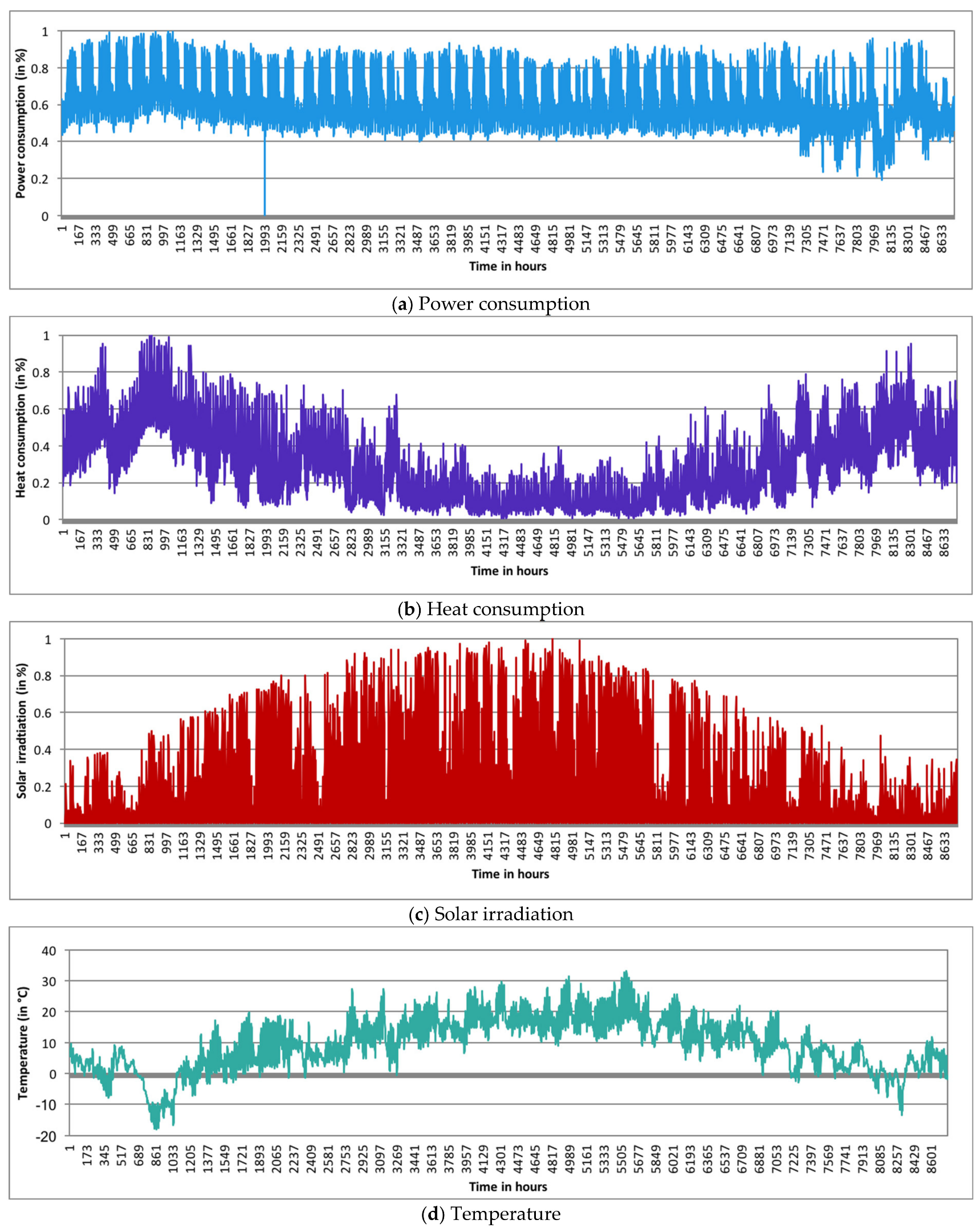
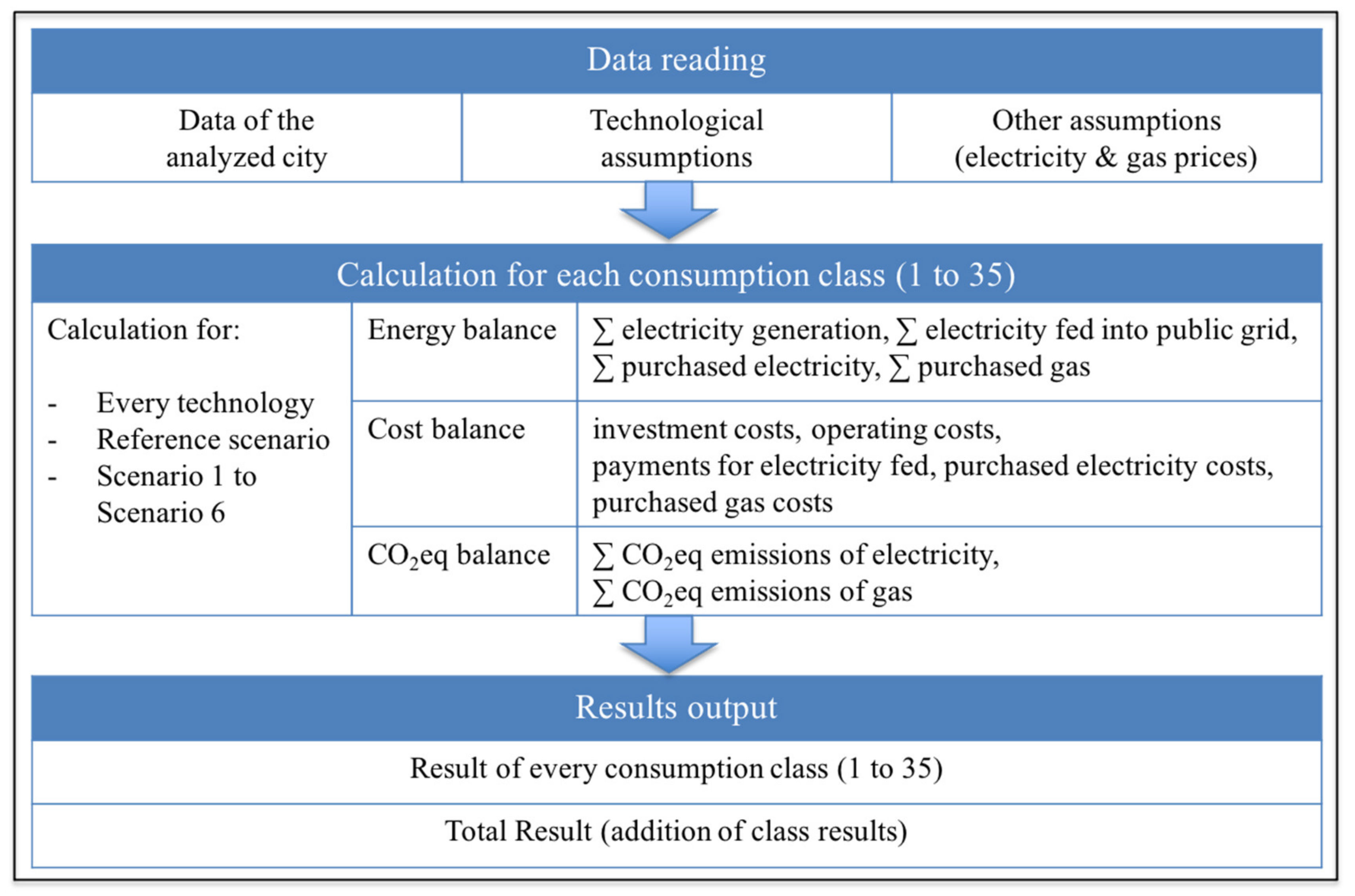
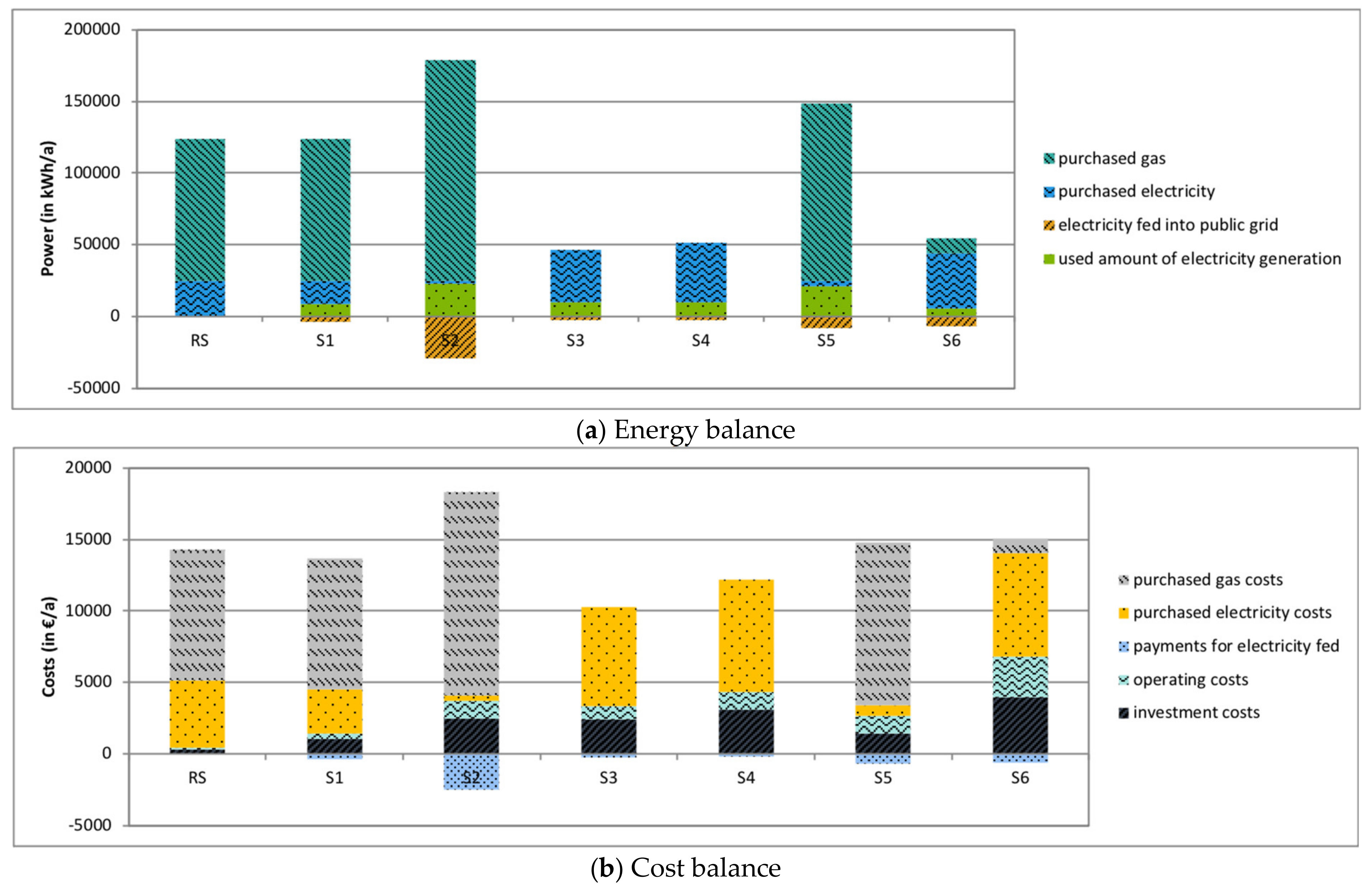


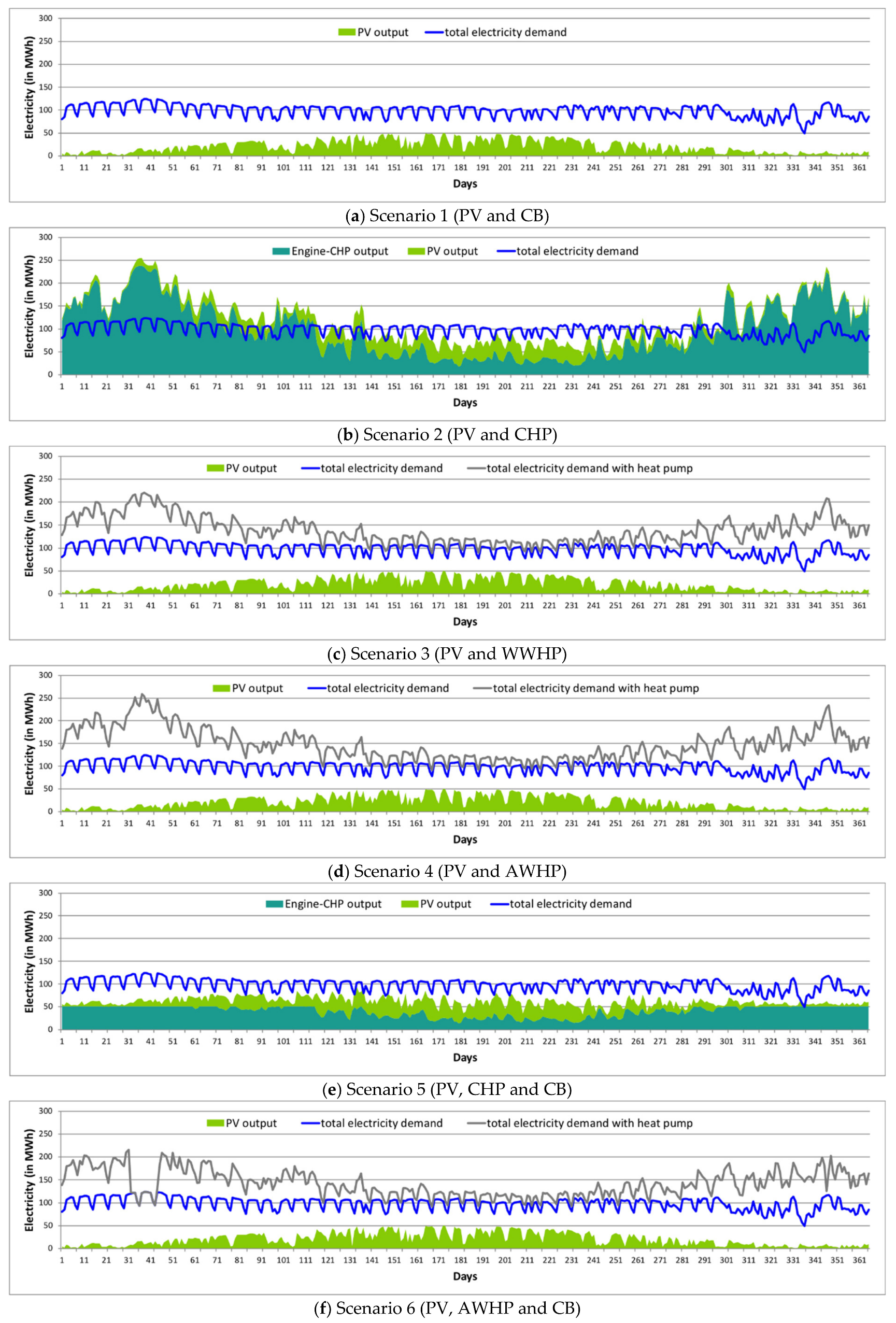
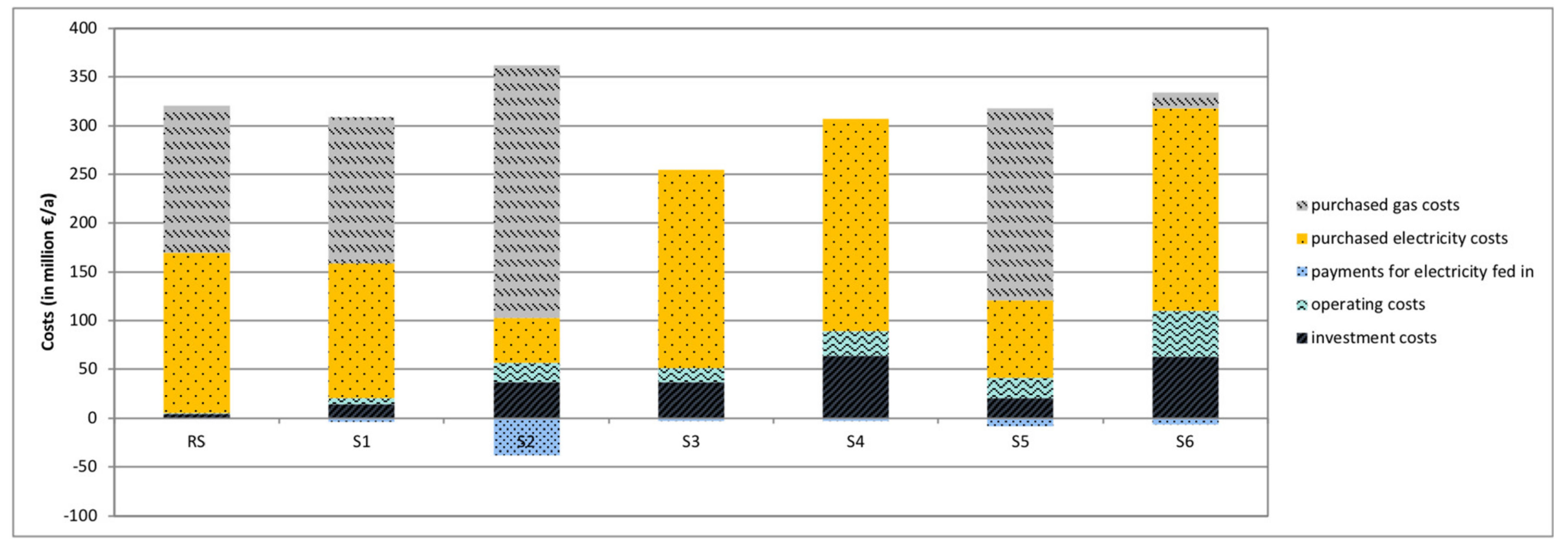

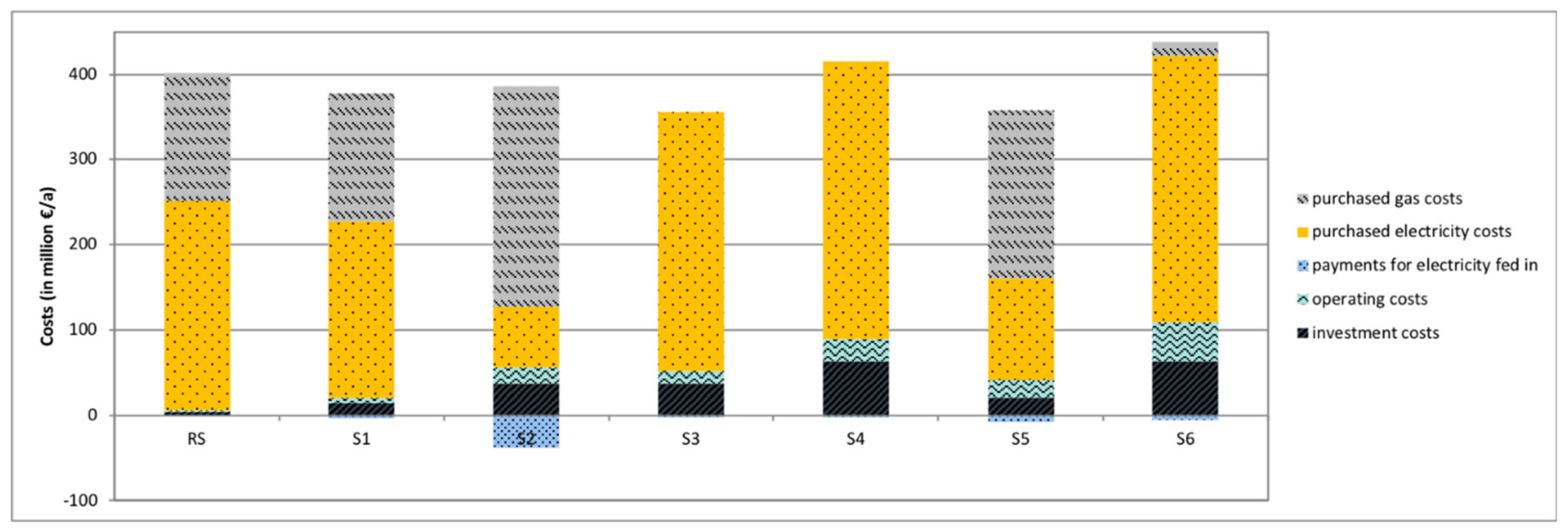
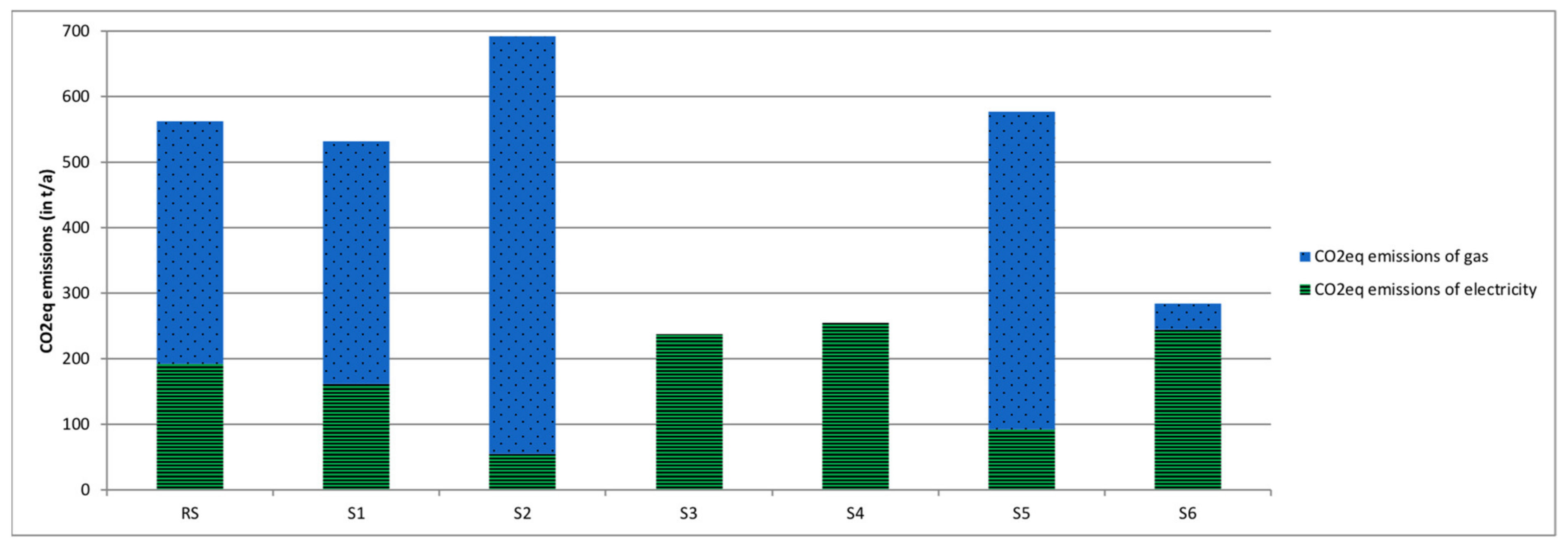
| Technology | Ref. | 1 | 2 | 3 | 4 | 5 | 6 |
|---|---|---|---|---|---|---|---|
| PV | - | x | x | x | x | x | x |
| Engine-CHP | - | - | x | - | - | x | - |
| HP | - | - | - | WWHP | AWHP | - | AWHP |
| CB | x | x | - | - | - | x | x |
Publisher’s Note: MDPI stays neutral with regard to jurisdictional claims in published maps and institutional affiliations. |
© 2021 by the authors. Licensee MDPI, Basel, Switzerland. This article is an open access article distributed under the terms and conditions of the Creative Commons Attribution (CC BY) license (https://creativecommons.org/licenses/by/4.0/).
Share and Cite
Crimmann, M.; Madlener, R. Assessing Local Power Generation Potentials of Photovoltaics, Engine Cogeneration, and Heat Pumps: The Case of a Major Swiss City. Energies 2021, 14, 5432. https://doi.org/10.3390/en14175432
Crimmann M, Madlener R. Assessing Local Power Generation Potentials of Photovoltaics, Engine Cogeneration, and Heat Pumps: The Case of a Major Swiss City. Energies. 2021; 14(17):5432. https://doi.org/10.3390/en14175432
Chicago/Turabian StyleCrimmann, Martina, and Reinhard Madlener. 2021. "Assessing Local Power Generation Potentials of Photovoltaics, Engine Cogeneration, and Heat Pumps: The Case of a Major Swiss City" Energies 14, no. 17: 5432. https://doi.org/10.3390/en14175432
APA StyleCrimmann, M., & Madlener, R. (2021). Assessing Local Power Generation Potentials of Photovoltaics, Engine Cogeneration, and Heat Pumps: The Case of a Major Swiss City. Energies, 14(17), 5432. https://doi.org/10.3390/en14175432






